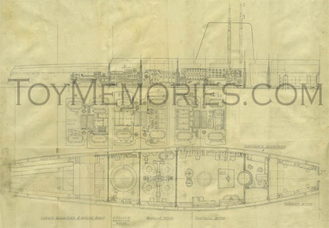Original Technical and Design Drawings in the Toy Memories Archives
|
In the toy industry, much like any other industry, technical drawings and production material is vital in the manufacturing processes. But what happens when the job is done? When the toys in question have been produced, and gradually reach the end of their "lifespan"? To the individuals involved, these are just one more "tool"; a detail, now no longer necessary. Sadly over the years, too much of this material is discarded when it is found to be "no longer useful". Material, which in all reality should be considered important art, for it was indeed produced by skilled artists and craftsmen in an age before computers and digital manipulation. It is a crime so much of it has been carelessly thrown in the trash heap over the years. But wait! Thank heaven for a number of individuals who had the foresight to preserve some of these treasures for future generations; whose pride in their work would not allow them to let this material be lost forever...
|
The various artwork that goes into the making of every toy is fascinating, beautiful, and required great patience and skill to create, especially in the days before modern computers. Beautifully sculpted, carved, formed or machined prototypes; imaginitive and stylized concept drawings; precision design and technical drawings; blueprints, and other artwork is just part of what went into the creation of every toy. The artisans and designers of most of the toys from our childhood years did amazing work. They enabled our fondest memories, and helped guide many of us on our journey through life. Without the toymakers, there surely would be no "real" toys, yet these talented people so rarely get the recognition they deserve. Initials on a drawing... or perhaps a clever artist left his hidden "mark" on a prototype or piece of artwork... they really do deserve more than to be lost in time, unknown, uncredited... with the manufacturer taking sole credit for their labor and creations.
|
Technical drawings were usually done on vellum, a thin paper-type material that allows light to pass through it to a degree. Other materials have been used (including a fiber-impregnated material). Drawings are done predominantly in pencil, and then a smaller number of them may be inked over the pencil for more pronounced detail. Vellum is a very sturdy material, so drawings can be repeatedly updated, changed, etc., and it can be erased repeatedly. Inking is not terribly common as the ink tends to make the image more permanent; designs change regularly, so using only pencil does the trick, and is dark enough for the next step- blueprints.
The vellum is semi-transparent; the pencil or ink is not. So, from what I understand (in a nutshell), the usual practice in years past was to use a Diazo machine in which you placed the vellum and a sheet of blueprint paper, and through a process involving an ammonia vapor and light, the image on the vellum was transferred to the blueprint paper.
|
From the ToyMemories archives, here you can see a small variety of original hand-drawn technical drawings from Ideal Toys and other toy companies ranging from the 1940's to the 1970's. Notice any favorites? Ideal's technical drawings were usually a little nicer than other manufacturers, and they tended to add a little more detail and a bit more depth than needed (many other toy companies' technical drawings were more on the "flat" side). Here's a chance to see a little of the "behind-the-scenes" work that went into making some classic toys; material that has never before been seen by the public, yet which deserves a place of honor. It should be recognized for the important part it played in many of our fondest childhood memories.
|
|
 |
| A Remco Classic |
|
|
Photo Album Gallery Place Holder - Please wait while the Photo Album loads.
If the album does not show, please refresh the page to try again.
|
|